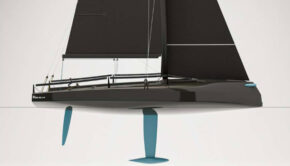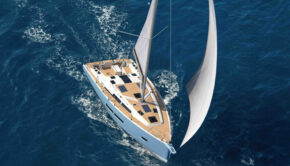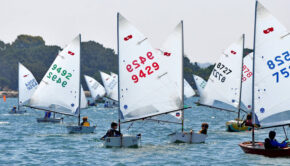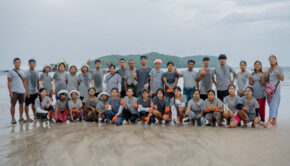Lyman-Morse: Forty Years of Innovation
Published on February 8th, 2018
Cabot Lyman has plenty of reasons to be proud. The company he founded has launched more than 110 yachts into the St. George River and has delivered everything from carbon fiber catamarans and traditional sloops to canting-keel monohulls, stately motor yachts, sportfishing powerboats, daysailers, and sporty jet boats to customers around the world.
Lyman-Morse Boatbuilding (Thomaston, ME) has prospered and diversified in a challenging marine industry that has been hit hard by recessions and changing lifestyles. Through this diversification, its 120-plus employees have introduced their work into new markets, their craftsmanship now finding its way into fine homes, colleges, and institutions worldwide.
And yet of all the accolades Lyman-Morse has received over the past 40 years, there’s one that this businessman cherishes most: Family owned and operated. Cabot and Heidi Lyman ran the company for more than three decades and their sons, Zach, Alex, and Drew, have each had a role in the business along the way. In 2013, Drew took over as president.
The Lyman-Morse story began in 1978, when the Lymans arrived in Maine from Vermont and purchased the building and land of the old Morse Boatbuilding Company in Thomaston. The owner of the company had died and Cabot and Heidi needed space to work on their recently purchased hull and deck of a Halvorsen-designed Freya 39.
The original plan was to finish the Freya 39 as a spec boat, so Cabot only planned on renting the space until he had time to build a shop of his own. But it turned out that Roger Morse, the shop’s foreman and nephew of the recently deceased owner, was holding two contracts for the conversion of Jarvis Newman 46 hulls that were then becoming popular. He needed help finishing them, so Cabot signed on.
As it turned out, both of the clients were seasoned bluewater yachtsmen who were committed to Cabot and were willing to trust him, a sailor-turned-Maine boatbuilder, with their projects. “Those guys were two of the best customers you could ever have when you’re starting a boat business,” Cabot said.
Before long, Roger moved on and the new company, Lyman-Morse Boatbuilding, had completed four lobsterboat conversions. (And yes, Cabot did finish that Freya 39. Named Rubicon, it was launched in 1980 and is owned to this day by Cabot’s brother Warren.)
Through numerous conversations with potential clients, Cabot soon started developing and planning the Lyman-Morse Seguin 44 sailing yacht series, designed by Sparkman & Stephens. With the launch of the first Seguin 44 hull in 1981, Lyman-Morse hit the market at just the right time, as many other boatbuilders were transitioning from custom to production work in an effort to lower cost and appeal to a larger market.
Fourteen Seguin 44s were launched, each yacht tailored specifically to the owner’s individual tastes and style. Every Lyman-Morse boat also utilized the engineered composites, high-end joinery, and sophisticated machinery and electronics that high-end yacht owners had come to expect.
As is often the case with a successful yacht, the popularity of the Seguin 44 spawned several variations: five Seguin 40s, three Seguin 49s and one Seguin 52 followed. “What an exciting time to be a young boat builder – We were suddenly looking at a two-year backlog,” said Cabot.
As luck would have it, some very exceptional employees – many of whom are still with the company – began to arrive, people who were flexible, talented, and dedicated. “Maine has turned out to be, perhaps, the finest place in the country to find exceptional and dedicated people to work with,” Cabot said. “The work ethic here is simply unsurpassed.”
In 1987, Lyman-Morse built the first of a series of C. Raymond Hunt-designed custom power boats, a relationship with the legendary naval architecture firm that would grow over the next three decades and continues today. Cabot was also buying property and physically expanding the yard. In 1995 he purchased the Renaissance building just in time to start the company’s largest project, the 90’ C. Raymond Hunt-designed Tumblehome.
The era of “big boats” had begun. From the late nineties into the new century, Lyman-Morse built several Ted Fontaine-designed cruising sailboats. Composite construction also hit its stride, and the company was chosen to build Baraka, Lyman-Morse’s first all-carbon sailboat, designed by Reichel Pugh. With these big projects under its belt, clients and naval architects have Lyman-Morse on a short list of yards that can handle the intricacies of high-end custom boatbuilding.
Designers and their firms such as Sparkman & Stephens, Doug Zurn, Chuck Paine, Jim Taylor, Jay Paris, Stephens Waring Yacht Design, C. Raymond Hunt, Ted Fontaine, Michael Porter, Mark Fitzgerald, Pursak & Wurmfeld, Bruce Farr, Bob Perry, Robert Ullberg, Ward Setzer, Morrelli & Melvin, Deiter Empacher, Reichel/Pugh, and Rodger Martin regularly seek out Lyman-Morse to build their projects.
Growing in tandem with Lyman-Morse’s boatbuilding business has been its servicing of fine yachts. Repairs, rebuilds and servicing ship systems, along with upgrading gear and seasonal maintenance, are handled by the service division of the company.
The 11-acre Thomaston campus features seven heated work buildings with 55,000 square feet of space for refit and repair/and boatbuilding. In keeping with the company’s focus on technology and innovation, recent capital investments have included a CNC machine, plasma cutter, 3D printer, and Travelifts and cranes that can haul yachts up to 110 tons.
Lyman-Morse’s willingness to innovate and take risks sometimes has meant purchasing an entirely new business, as it did in 2003 with the purchase of a fabrication shop.
Lyman-Morse Fabrication is fast becoming the source for top-quality, custom-made metal projects in New England – whether they’re destined for a fine yacht, fine home, or even an industrial setting. Lyman-Morse Fabrication mirrors the boatbuilding and service divisions in specializing in complex commercial, municipal, and residential design, engineering, and fabrication projects, regardless of job size.
All Lyman-Morse divisions work closely with Lyman-Morse Technologies, the research, development, and prototyping division of the company. Architects, interior designers, business and home owners, and government agencies utilize Lyman-Morse Technologies’ skills and experience to fuse state-of-the-art design, the latest technology, and superior craftsmanship.
Whether it’s replacing a decaying church steeple with a nearly maintenance-free composite spire or creating a radome for advanced jet aircraft, the Lyman-Morse Technologies team has proven its ability to respond to the most unique projects worldwide.
In 2007, Cabot’s son Drew stepped into the role of service manager at Lyman-Morse. As Drew assumed more day-to-day responsibilities, Cabot and Heidi had more time to spend cruising and pursuing other interests. One of those pursuits includes the construction of 250 Main, the first boutique hotel in Rockland, Maine. The stylish accommodations, designed with the same attention to detail and excellence as every Lyman-Morse yacht, opened in 2016 to fantastic reviews.
In 2015 Lyman-Morse acquired Wayfarer Marine in Camden, a full-service marina located in one of the most scenic harbors in New England and a destination for yachtsmen worldwide. The company’s presence in Camden gives Lyman-Morse increased visibility and the opportunity to return the Camden yard to its former glory as New England’s go-to marine service center.
Under Drew’s leadership, the sales team has also expanded to include five brokers in three locations: Camden and Southwest Harbor, Maine, and Newport, Rhode Island. “Having a team of experienced bluewater mariners who understand what proper maintenance is all about is the reason discerning and demanding yachtsmen deliver their yachts to Lyman-Morse,” Drew said.
From this new Camden location, Drew founded the Camden Classics Cup, a two-day sailing regatta that is augmented with community events and is held at the end of July, on the weekend before the Eggemoggin Reach Regatta. In 2018, the Camden Classics Cup enters its third year and plans to have even more than last year’s 52 registered boats jockeying for position on the starting line.
Source: Marnie Read, Lyman-Morse









 We’ll keep your information safe.
We’ll keep your information safe.